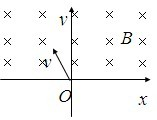问题
单项选择题
二度Ⅰ型房室传导阻滞的心电图特征是()
A.P-R间期进行性缩短,直至一个P波受阻不能下传到心室
B.相邻P-R间距进行性延长,直至一个P波受阻不能下传到心室
C.P-R间期进行性延长,直至一个P波受阻不能下传到心室
D.P-R间期>0.20秒,P波无受阻
E.P-R间期固定,P波间断受阻不能下传到心室
答案
参考答案:C
解析:二度房室传导阻滞可分为两型。Ⅰ型又称文氏现象,或称莫氏Ⅰ型,Ⅱ型又称莫氏Ⅱ型。文氏现象特点:①P-R间期逐渐延长,直至P波受阻与心室脱漏,②R-R间期逐渐缩短,直至P波受阻;③包含受阻P波的R-R间期比两个P-P间期之和为短。莫氏Ⅱ型特点:①P-R间期固定,可正常或延长。②QRS波群有间期性脱漏,阻滞程度可经常变化,可为1:1;2:1;3:1;3:2;4:3等。下传的QRS波群多呈束支传导阻滞图型

 v/aB,正电荷
v/aB,正电荷 v/aB,负电荷
v/aB,负电荷